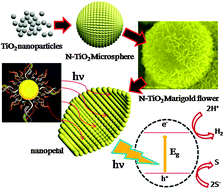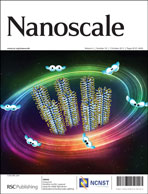Nanostructured N-doped TiO2 marigold flowers for an efficient solar hydrogen production from H2S†
Abstract
Nitrogen-doped TiO2 nanostructures in the form of marigold flowers have been synthesized for the first time using a facile solvothermal method. The structural analysis has shown that such an N-doped TiO2 system crystallizes in the anatase structure. The optical absorption spectra have clearly shown the shift in the absorption edge towards the visible-light range, which indicates successful nitrogen doping. The nitrogen doping has been further confirmed by photoluminescence and photoemission spectroscopy. Microscopy studies have shown the thin nanosheets (petals) of N–TiO2 with a thickness of ∼2–3 nm, assembled in the form of the marigold flower with a high surface area (224 m2 g−1). The N–TiO2 nanostructure with marigold flowers is an efficient photocatalyst for the decomposition of H2S and production of hydrogen under solar light. The maximum hydrogen evolution obtained is higher than other known N–TiO2 systems. It is noteworthy that photohydrogen production using the unique marigold flowers of N–TiO2 from abundant H2S under solar light is hitherto unattempted. The proposed synthesis method can also be utilized to design other hierarchical nanostructured N-doped metal oxides.


 Please wait while we load your content...
Please wait while we load your content...